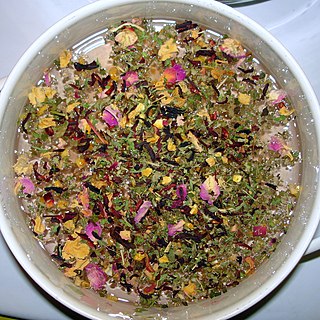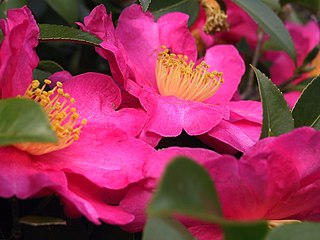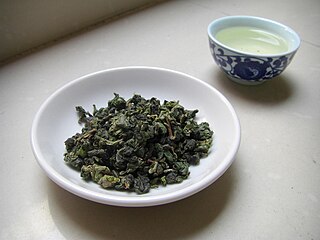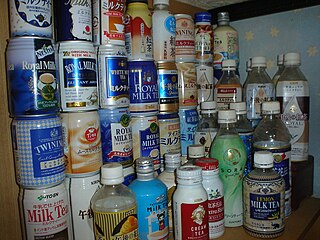
Oolong (, ; simplified Chinese: 乌龙茶; traditional Chinese: 烏龍茶 is a traditional semi-oxidized Chinese tea produced through a process including withering the plant under strong sun and oxidation before curling and twisting. Most oolong teas, especially those of fine quality, involve unique tea plant cultivars that are exclusively used for particular varieties. The degree of oxidation, which varies according to the chosen duration of time before firing, can range from 8 to 85%, depending on the variety and production style. Oolong is especially popular in south China and among ethnic Chinese in Southeast Asia as is the Fujian preparation process known as the gongfu tea ceremony.

Herbal teas, also known as herbal infusions and less commonly called tisanes, are beverages made from the infusion or decoction of herbs, spices, or other plant material in hot water. Oftentimes herb tea, or the plain term tea, is used as a reference to all sorts of herbal teas. Many herbs are used in herbal medicine. Some herbal blends contain actual tea.

Theobromine, also known as xantheose, is the principal alkaloid of Theobroma cacao. Theobromine is slightly water-soluble (330 mg/L) with a bitter taste. In industry, theobromine is used as an additive and precursor to some cosmetics. It is found in chocolate, as well as in a number of other foods, including the leaves of the tea plant, and the kola nut. It is a white or colourless solid, but commercial samples can appear yellowish.

Camellia is a genus of flowering plants in the family Theaceae. They are found in tropical and subtropical areas in eastern and southern Asia, from the Himalayas east to Japan and Indonesia. There are more than 220 described species. Camellias are popular ornamental, tea and woody-oil plants that have been cultivated throughout the world for centuries. To date, over 26,000 cultivars, with more than 51,000 cultivar names including synonyms, have been registered or published.

Green tea is a type of tea that is made from Camellia sinensis leaves and buds that have not undergone the same withering and oxidation process which is used to make oolong teas and black teas. Green tea originated in China, and since then its production and manufacture has spread to other countries in East Asia.

Flavonoids are a class of polyphenolic secondary metabolites found in plants, and thus commonly consumed in the diets of humans.

Camellia sinensis is a species of evergreen shrub or small tree in the flowering plant family Theaceae. Its leaves and leaf buds are used to produce black and green tea. Common names include tea plant, tea shrub, and tea tree.
Although health benefits have been assumed throughout the history of using Camellia sinensis as a common beverage, there is no high-quality evidence that consuming tea confers significant benefits other than possibly increasing alertness, an effect caused by caffeine in the tea leaves. In clinical research conducted over the early 21st century, tea has been studied extensively for its potential to lower the risk of human diseases, but there is no good scientific evidence to indicate that consuming tea affects any disease or improves health.
Decaffeination is the removal ("de-") of caffeine from coffee beans, cocoa, tea leaves, and other caffeine-containing materials. Decaffeinated products are commonly termed by the abbreviation decaf. Decaffeinated drinks contain typically 1–2% of the original caffeine content, and sometimes as much as 20%.

Tieguanyin is a variety of Chinese oolong tea that originated in the 19th century in Anxi in Fujian province. Tieguanyin produced in different areas of Anxi have different gastronomic characteristics.

Cruciferous vegetables are vegetables of the family Brassicaceae with many genera, species, and cultivars being raised for food production such as cauliflower, cabbage, kale, garden cress, bok choy, broccoli, Brussels sprouts, mustard plant and similar green leaf vegetables. The family takes its alternative name from the shape of their flowers, whose four petals resemble a cross.

Kaempferol (3,4′,5,7-tetrahydroxyflavone) is a natural flavonol, a type of flavonoid, found in a variety of plants and plant-derived foods including kale, beans, tea, spinach, and broccoli. Kaempferol is a yellow crystalline solid with a melting point of 276–278 °C (529–532 °F). It is slightly soluble in water and highly soluble in hot ethanol, ethers, and DMSO. Kaempferol is named for 17th-century German naturalist Engelbert Kaempfer.

Canned tea is a relatively recent method of marketing tea which has been sold traditionally as leaf tea and also, for the last 100 years, in tea bag form. It utilises the canning process to produce a ready made drink. Perceived advantages includes ease of use and the possibility of additives ; the disadvantages are the cost of shipment and a lack of freshness.

High-mountain tea or gaoshan tea refers to several varieties of Oolong tea grown in the mountains of central Taiwan. It is grown at altitudes higher than 1,000 metres (3,300 ft) above sea level, and includes varieties such as Alishan, Dayuling, Yu Shan, Wushe, and Lishan. The high humidity and natural precipitation in the high mountain ranges of Nantou and Chiayi Counties make the region a suitable environment for growing tea plants. High Mountain Oolong is a tea that holds all of its original nutrients that are within the unfermented green tea. It does not hold the usual grass-like taste, hints of chestnut flavor paired with nutty aromas are often described. The fermentation process that removes the harsh ingredients allows the tea to taste flavorful.
Caffeine synthase is a methyltransferase enzyme involved in the caffeine biosynthesis pathway. It is expressed in tea species, coffee species, and cocoa species. The enzyme catalyses the following reactions:

The phenolic content in tea refers to the phenols and polyphenols, natural plant compounds which are found in tea. These chemical compounds affect the flavor and mouthfeel of tea. Polyphenols in tea include catechins, theaflavins, tannins, and flavonoids.

Theacrine, also known as 1,3,7,9-tetramethyluric acid, is a purine alkaloid found in Cupuaçu and in a Chinese tea known as kucha. It shows anti-inflammatory and analgesic effects and appears to affect adenosine signalling in a manner similar to caffeine. In kucha leaves, theacrine is synthesized from caffeine in what is thought to be a three-step pathway. Theacrine and caffeine are structurally similar.

Black tea is a type of tea that is more oxidized than oolong, yellow, white and green teas. Black tea is generally stronger in flavour than other teas. All five types are made from leaves of the shrub Camellia sinensis, though Camellia taliensis is also used rarely.

Camellia taliensis is a species of evergreen shrub or small tree whose leaves and leaf buds are used to produce tea.
Insect tea refers to teas made from leaves bitten by, and the droppings of, insects fed on specific plants. Most insect teas originate from the Southeast Asian region. They are often used in local traditional medicine, but have not been well-studied in the scientific literature.















